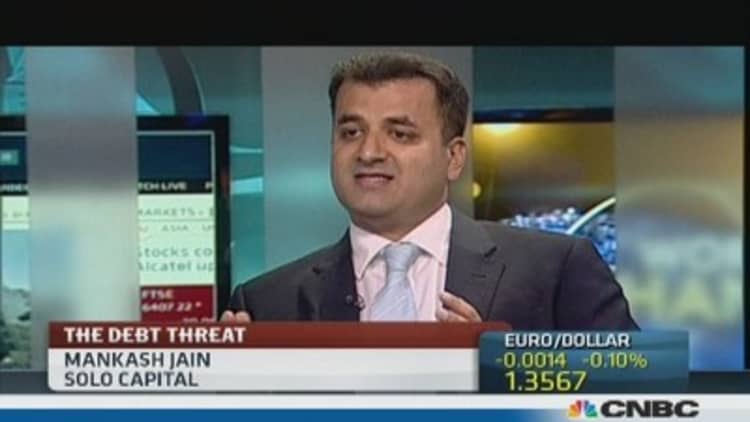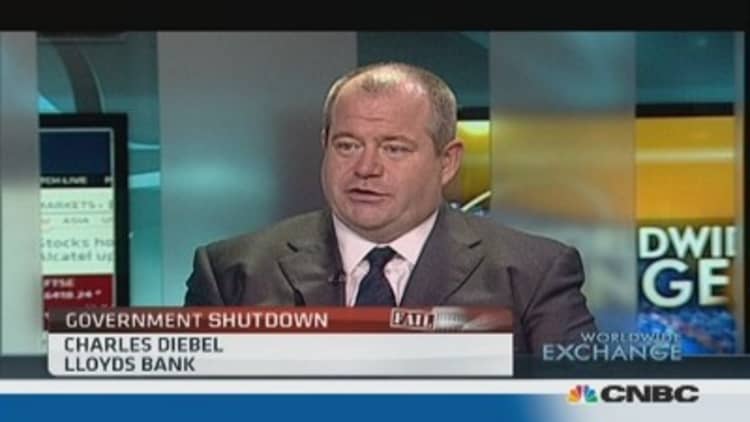"The United States government is not going to default, ever."
That's what Vincent Reinhart, former head of the Federal Reserve's monetary division and now managing director and chief United States economist for Morgan Stanley, said late last week.
"As political theater," he said, "the debt ceiling is not a useful threat, because politicians are basically threatening to shoot themselves, as they will rightly shoulder the blame for the serious global economic consequences of a default."
Mr. Reinhart's view has become conventional wisdom on Wall Street when it comes to whether the country will hit the debt ceiling limit on Oct. 17. Warren Buffett put it this way: "We'll go right up to the point of extreme idiocy, but we won't cross it."
(Read more: Buffett speaks out against DC's 'extreme idiocy')

Nobody believes the country will actually exceed the debt limit — which is exactly why it might.
Oddly enough, despite all the predictions of panic, the stock market was down only marginally over the last couple of sessions.
Here's the perversity of Wall Street's psychology: The more Wall Street is convinced that Washington will act rationally and raise the debt ceiling, most likely at the 11th hour, the less pressure there will be on lawmakers to reach an agreement. That will make it more likely a deal isn't reached.
John Podesta, the former chief of staff for President Bill Clinton, said that while only weeks ago he thought it was almost impossible that Congress wouldn't reach a deal, he now questions whether it will be reached in time.
What happens when the government exceeds the debt limit? It is often forgotten, but it actually did default once, in 1979 — but this was by accident.
More from The New York Times:
Little Fear on Wall Street of U.S. Defaulting on Its Debt
A G.O.P. Moderate in the Middle of a Jam
Threat of U.S. Default Sparks Fear Around Globe
Here's a history lesson from Donald B. Marron of the Tax Policy Center: He wrote on his blog in 2011 — the last time this game of chicken was taking place — that Congress raised the debt ceiling at the 11th hour in 1979 but the government "defaulted because Treasury's back office was on the fritz." He explained that the government ultimately paid the debt back in full.
So what happened to interest rates? "T-bill rates rose almost 0.6 percentage points (i.e., 60 basis points). There's no indication this increase reversed in the days that followed." That may sound like a lot — and it is — but let's put that in context: "T-bill rates hover near zero compared to the 9-10 percent range of the late-1970s; that means a temporary delay in payments would be less costly for creditors."
(Read more: Spike in T-bill yields shows default fears growing)
Of course, for the last several weeks we have heard ad nauseam about how imperative it is for Congress to raise the debt ceiling or risk imperiling the creditworthiness of the United States. Even approaching the deadline without a resolution was supposed to send the market into a panic and interest rates skyrocketing.
And yet here we are, about a week before the deadline, and the market hasn't cratered despite remarks over the weekend by House Speaker John A. Boehner, who indicated, for the first time, that he planned to use the debt ceiling as a negotiating chip in seeking concessions from President Obama, who has steadfastly refused to negotiate. "I told the president, there's no way we're going to pass one," Mr. Boehner said. "The votes are not in the House to pass a clean debt limit. And the president is risking default by not having a conversation with us."
Almost bizarrely, the market's reaction — or lack of one in this case — may actually contribute to an outcome everyone has been railing against.

The ruinous potential for a default has had Wall Street leaders screaming from the rooftops: "Whatever circumstances and disagreements got us to this current unhappy juncture, there is no way that our government leaders can allow the full faith and credit of the United States of America to be jeopardized. This is an issue that affects every single citizen, from veterans to Social Security recipients to government bondholders to all taxpayers, and threatens to derail an already fragile economic recovery," James P. Gorman, the chief executive of Morgan Stanley, said in an e-mail to his employees, urging them to contact their representatives in Washington.
Goldman Sachs put it this way: "A very short delay past the October deadline — for instance, a few days — could delay the payment of some obligations already incurred and would create instability in the financial markets." He added, "This uncertainty alone could weigh on growth."
For some market participants, the prospect of reaching the debt limit isn't worrisome, not because they don't think a deal will be reached but because — and I disagree with this — they believe that the Oct. 17 deadline is either fake — they speculate that Treasury Secretary Jacob J. Lew has built in some wiggle room to force a decision — or that the government would ultimately be able to prioritize certain payments over others so that it could continue to pay its debts and Social Security payments. Of course, the Treasury disputes that, saying it is impossible to prioritize the millions of payments that the government makes every day.
(Read more: If US defaults, how low will the Dow go?)
In 2011, Stanley F. Druckenmiller, the hedge fund manager, told The Wall Street Journal: "I think technical default would be horrible, but I don't think it's going to be the end of the world. It's not going to be catastrophic. What's going to be catastrophic is if we don't solve the real problem."
He is right about the need to solve the big problems. But unless we sit up and pay attention, we may create an even larger one.
—By CNBC anchor and New York Times writer Andrew Ross Sorkin. Follow him on Twitter @andrewrsorkin

